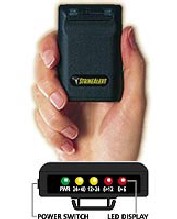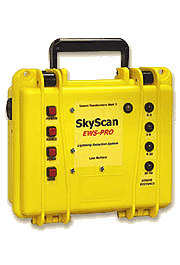|
How do Lightning Detectors Save Lives?Good lightning detectors, used sensibly, greatly reduce the risk of personal lightning strike by providing timely warning of approaching thunderstorms. But how real are the chances of becoming a victim of a lightning strike? Lightning is the second most deadly type of weather - only floods are more lethal. On average, 600 people in the USA will be struck by lightning each year, and 80 will die. Many of those who survive will be severely injured, and recovery can be long and painful. Lightning is also unpredictable - even sneaky. While most strikes occur close to the rain, hail and winds of a thunderstorm, a significant proportion occur well before or after the main part of the storm has passed. For more information visit the Lightning page. Strikes 10 miles (16km) or more ahead of the storm are not uncommon, and while the storm may be visible in open country, at this distance thunder may not be heard. These sorts of strikes are often referred to as "bolts from the blue" Overall, your chances of being struck by lightning are low - about 1 in 50,000 in the USA, which still represents better odds than the chance of winning a lottery. Nevertheless, the odds become much shorter if you are working outside, playing sport, picnicking, boating or in high country when a thunderstorm is in the area. One particular form of risk occurs during outdoor team sports such as baseball or soccer, where players on the field are the highest points for several tens of yards, and are therefore the most likely point of contact. Imagine how devastating it would be for the coach, manager and parents of a kids team to see someone killed or injured by unexpected lightning during a game. There is no reason to expose teams and supporters to this risk - any one of a number of lightning detectors can give enough warning to move everyone to safety, and will also indicate when it's safe to resume. Lightning SensorsLightning occurs when a large spark jumps between areas with different electrostatic charges within or near a thunderstorm. This spark causes radio interference, best known as the static which interferes with AM radio broadcasts. In fact, your AM radio is a primitive form of lightning sensor, but apart from some increase in intensity of the static as the storm approaches, it gives no guide to distance or direction. More useful are the yard lightning detectors or sensors. They consist of an aerial of some form, often on a pole, connected to a receiver which can be preset to sound an alarm when the storm is becoming a potential threat. The frequency of strikes can be heard, and gives a guide to the severity of the storm. Range varies with the height of the sensor above the ground. By following the installation instructions, you can set it up to pick up storms at whatever distance you feel is a sensible balance between risk and false alarm.As a general guide, a lightning detector 5 feet (1.5m)above the ground will detect lightning within 30 miles(48 km). Raising the sensor to 10 feet (3m) will extend therange to 100 miles or 160 km. Some can be battery operated and are portable, others can be fixed in your yard. If permanently installed, make sure someone qualified has earthed the sensor to ground - lightning detectors are targets too.
But before covering portable lightning detectors, it is worth mentioning a somewhat more robust detector which can be permanently installed anywhere from homes to sporting venues, or fitted to a vehicle for use with work crews at any location. This is the FMLA-1000, available from WeatherShop. Fixed units cost $249.00, mobile ones $349. With long lasting batteries, loud sirens, and easy controls detectors like these would be a great investment for any outdoor venue or sports club.
Portable Lightning Detectors
A number of portable lightning detectors take it a step further. Most of them will only react to cloud to ground strikes, and can give a rough idea of storm distance. Although they won't show direction, they can pick whether the storm is approaching or moving away.
One word of caution here. The manufacturers of lightning detectors and trackers are generally an optimistic lot, and things may not always work as well as they imply. Lightning detection is not all that precise, so regardless of whether you have a detector, don't forget to use your eyes and ears.
There are four main portables on the market, and you will probably want to compare your needs to their specific features. At under $80.00, the StrikeAlert Personal Lightning Detector will suit many requirements at a good price. It's pocket sized, runs off an AA battery with 100 hours of power, and has a range of 40 miles (65km). The SkyScan Lightning Detector is similar in capability, is somewhat larger and less portable, can run off AC or a car cigarette lighter, but retails close to $190.00
The above three lightning detectors are small, with a personal alarm, and in general wouldn't be appropriate for general warnings at outdoor gatherings. At the next level is the SkyScan EWS-PRO Lightning Detection System, which is specifically designed for outdoor use. The SkyScan EWS-PRO (there seems to be a rule for naming lightning detectors that says you must slip in an upper case letter halfway through the name) has a 12v rechargeable power source with a 7 day life, filtering and discrimination in favour of only cloud to ground strikes, and a 95db alarm which can be preset to any range within its 40mile (65km) detection area. The siren is backed up by LED visual alerts.
For more on pricing, check out the note at the bottom of the page. There is undoubtedly a good range of lightning detectors on the market, and overall the technology behind them is not particularly complex. I am sure you will find what you need amongst the models reviewed above - it's only a matter of sorting out your requirements and suiting them to the price you are prepared to pay. But if you need to know where the storm is, whether it's reallyheading your way, it's size and how fast it's moving you will needsomething more sophisticated, and you can find out what's availableon the Lightning Trackers page. For more information on lightning in general, visit the Lightning page., while here's the place to go if you are looking for More Lightning Resources. This link will take you back to the Top, or, when you're ready, here's how to return to the Home page. Click Here For Your Free 20 Page Report on Solving *Product links and pricing. The products I mention are, in my opinion, the best of the range in each category.But this doesn't mean they are just what you are lookingfor, and it is always worth following the link to the manufacturer's page. But don't buy from there - in almost all cases muchbetter prices are available from both shopfront and internetbased retailers. At all times eBay and Amazon are worthchecking out, and you will notice many of the links go toAmazon. Amazon has built a very sound reputation for customerservice, given the huge amount of business that passes throughtheir website, and many products are accompanied by cleardescriptions, alternatives, and reviews from customers. Thesecan be very helpful, and I shop at Amazon myself. But prices can change very quickly there, so if you have madeup your mind on a product and you see a good price there, grab it before it goes. Where possible, I provide links to other retailers where their prices are competitive. Some may be better than they seem ifthe prices include delivery and, where needed, batteries - check the terms they offer. Finally, I stand to make small commissions on some of the productsI recommend. A lot of work goes into building and maintaining asite like this, and I am not ashamed if I recoup some of the costs,and even make a little money on top. That being said, I will and do recommend sellers where I will notmake anything for myself. One of these is Ambient Weather, a useful retail site with good supporting information. But if you visit there, don't forget to come back! Last update 05/25/2011
|




 Lightning Detectors of this type - for example from
Lightning Detectors of this type - for example from

 Still more expensive at $460.00 is the ThunderBolt personal lightning detector - about the same size as the StrikeAlert but its range is extended to 75 miles or 100 km. It has lots of extra features - LCD messages and sophisticated calculations of ETA, approach speed etc, and runs off a 9v battery or AC adaptor. The obvious comparison is with the StrikeAlert, which looks to be much better value, if not quite as informative.
Still more expensive at $460.00 is the ThunderBolt personal lightning detector - about the same size as the StrikeAlert but its range is extended to 75 miles or 100 km. It has lots of extra features - LCD messages and sophisticated calculations of ETA, approach speed etc, and runs off a 9v battery or AC adaptor. The obvious comparison is with the StrikeAlert, which looks to be much better value, if not quite as informative.  All of these can be obtained from
All of these can be obtained from 